child seat DODGE CHALLENGER SRT 2018 Owner's Guide
[x] Cancel search | Manufacturer: DODGE, Model Year: 2018, Model line: CHALLENGER SRT, Model: DODGE CHALLENGER SRT 2018Pages: 486, PDF Size: 4.56 MB
Page 197 of 486

Frequently Asked Questions About Installing Child Restraints With Seat Belts
What is the weight limit (child’s weight + weight of the child re-
straint) for using the Tether Anchor
with the seat belt to attach a forward facing child restraint? Weight limit of the Child Restraint Always use the tether anchor when
using the seat belt to install a for-
ward facing child restraint, up to the recommended weight limit of the child restraint.
Rear Seat Delete — Only Front Passenger Seat Automatic
Locking Retractor (ALR) LocationPassenger Seat Delete — No Automatic Locking Retractor (ALR) Locations
5
SAFETY 195
Page 198 of 486
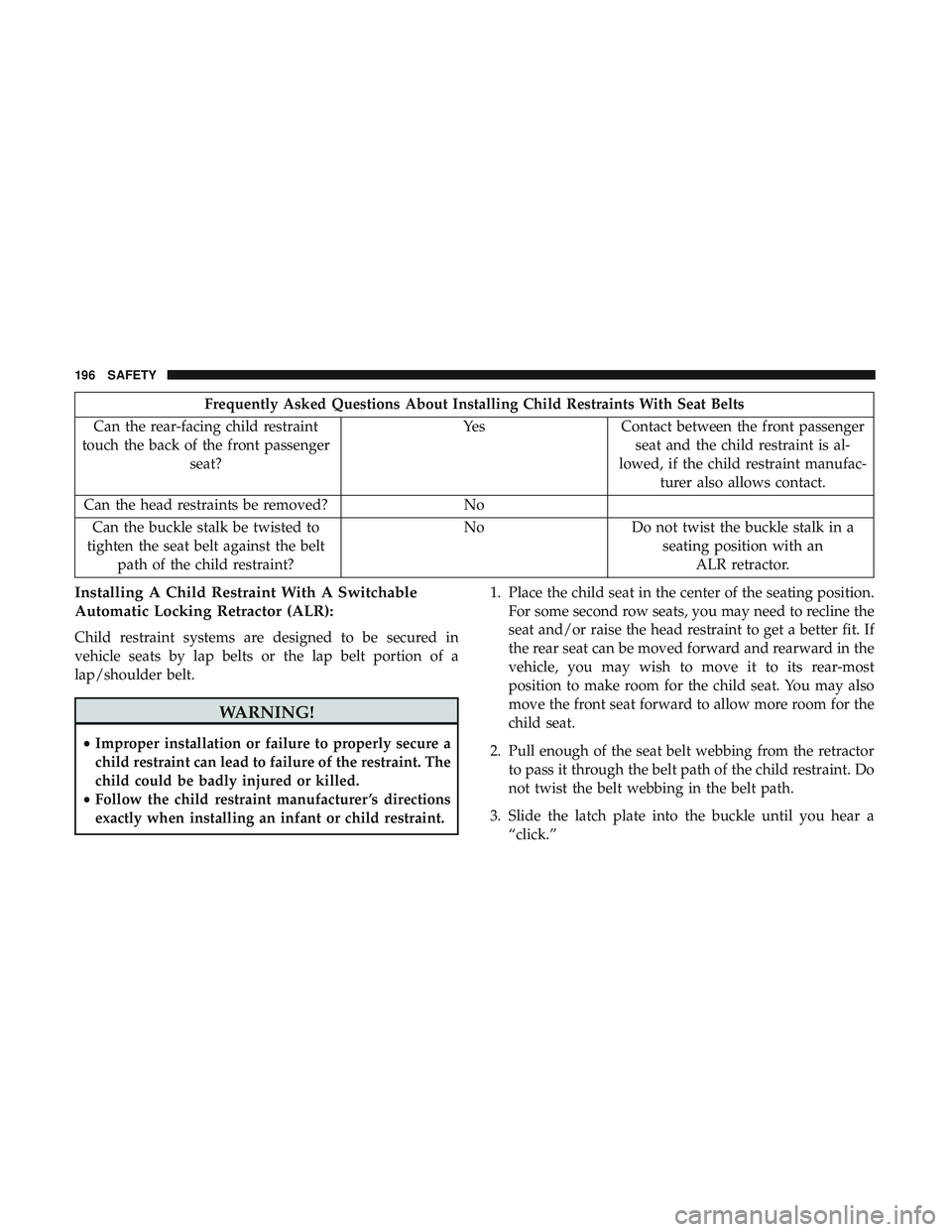
Frequently Asked Questions About Installing Child Restraints With Seat Belts
Can the rear-facing child restraint
touch the back of the front passenger seat? Yes Contact between the front passenger
seat and the child restraint is al-
lowed, if the child restraint manufac- turer also allows contact.
Can the head restraints be removed? No
Can the buckle stalk be twisted to
tighten the seat belt against the belt path of the child restraint? No
Do not twist the buckle stalk in a
seating position with an ALR retractor.
Installing A Child Restraint With A Switchable
Automatic Locking Retractor (ALR):
Child restraint systems are designed to be secured in
vehicle seats by lap belts or the lap belt portion of a
lap/shoulder belt.
WARNING!
•Improper installation or failure to properly secure a
child restraint can lead to failure of the restraint. The
child could be badly injured or killed.
• Follow the child restraint manufacturer ’s directions
exactly when installing an infant or child restraint. 1. Place the child seat in the center of the seating position.
For some second row seats, you may need to recline the
seat and/or raise the head restraint to get a better fit. If
the rear seat can be moved forward and rearward in the
vehicle, you may wish to move it to its rear-most
position to make room for the child seat. You may also
move the front seat forward to allow more room for the
child seat.
2. Pull enough of the seat belt webbing from the retractor to pass it through the belt path of the child restraint. Do
not twist the belt webbing in the belt path.
3. Slide the latch plate into the buckle until you hear a “click.”
196 SAFETY
Page 199 of 486

4. Pull on the webbing to make the lap portion tightagainst the child seat.
5. To lock the seat belt, pull down on the shoulder part of the belt until you have pulled all the seat belt webbing
out of the retractor. Then, allow the webbing to retract
back into the retractor. As the webbing retracts, you will
hear a clicking sound. This means the seat belt is now in
the Automatic Locking mode.
6. Try to pull the webbing out of the retractor. If it is locked, you should not be able to pull out any webbing.
If the retractor is not locked, repeat step 5.
7. Finally, pull up on any excess webbing to tighten the lap portion around the child restraint while you push the
child restraint rearward and downward into the vehicle
seat.
8. If the child restraint has a top tether strap and the seating position has a top tether anchorage, connect the
tether strap to the anchorage and tighten the tether
strap. See the section “Installing Child Restraints Using
the Top Tether Anchorage” for directions to attach a
tether anchor. 9. Test that the child restraint is installed tightly by pulling
back and forth on the child seat at the belt path. It
should not move more than 1 inch (25.4 mm) in any
direction.
Any seat belt system will loosen with time, so check the
belt occasionally, and pull it tight if necessary.
Installing Child Restraints Using The Top Tether
Anchorage:
WARNING!
If the rear or front passenger seats are not present in
your vehicle, NEVER install a child restraint in these
positions.
WARNING!
Do not attach a tether strap for a rear-facing car seat to
any location in front of the car seat, including the seat
frame or a tether anchorage. Only attach the tether
strap of a rear-facing car seat to the tether anchorage
that is approved for that seating position, located
behind the top of the vehicle seat. See the section
(Continued)
5
SAFETY 197
Page 200 of 486
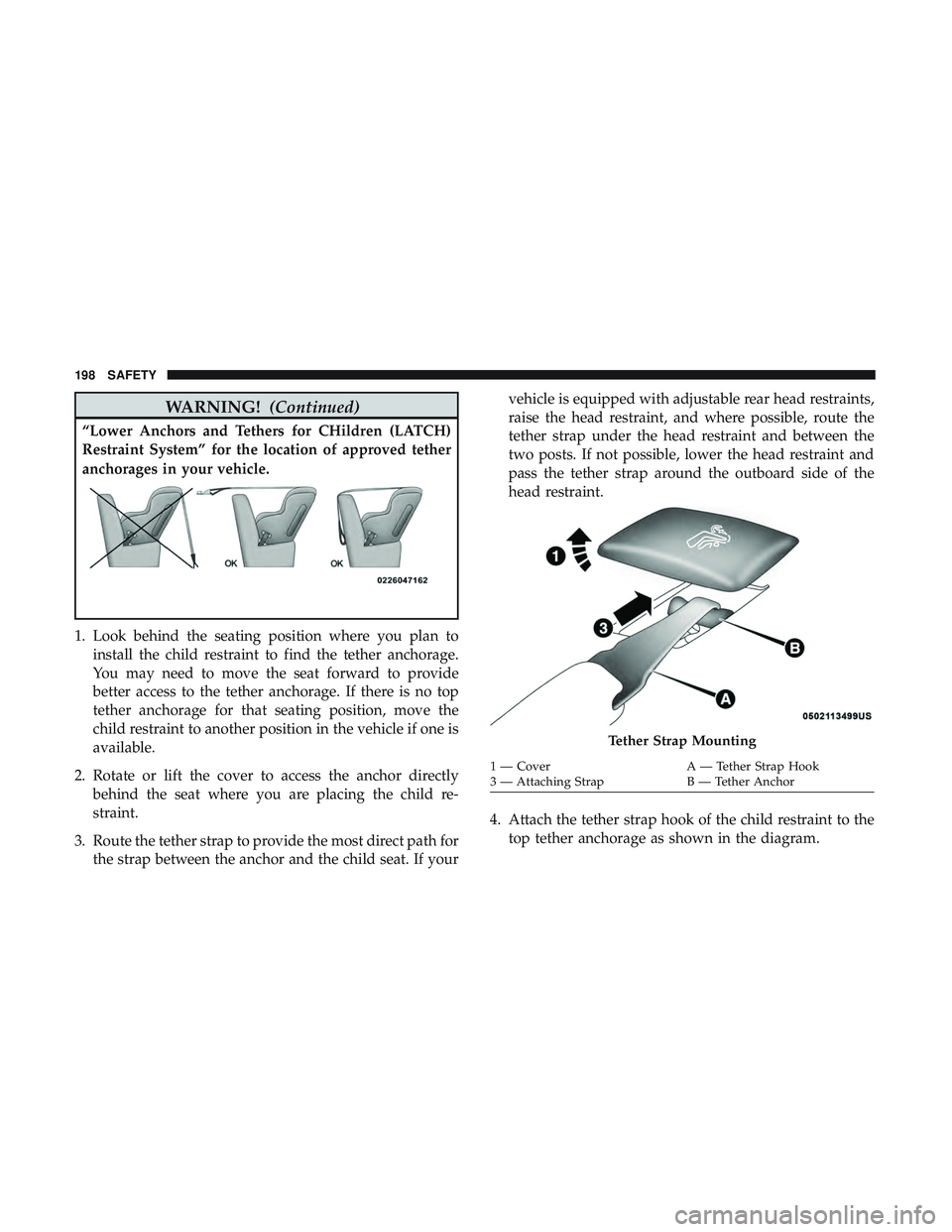
WARNING!(Continued)
“Lower Anchors and Tethers for CHildren (LATCH)
Restraint System” for the location of approved tether
anchorages in your vehicle.
1. Look behind the seating position where you plan to
install the child restraint to find the tether anchorage.
You may need to move the seat forward to provide
better access to the tether anchorage. If there is no top
tether anchorage for that seating position, move the
child restraint to another position in the vehicle if one is
available.
2. Rotate or lift the cover to access the anchor directly behind the seat where you are placing the child re-
straint.
3. Route the tether strap to provide the most direct path for the strap between the anchor and the child seat. If your vehicle is equipped with adjustable rear head restraints,
raise the head restraint, and where possible, route the
tether strap under the head restraint and between the
two posts. If not possible, lower the head restraint and
pass the tether strap around the outboard side of the
head restraint.
4. Attach the tether strap hook of the child restraint to the top tether anchorage as shown in the diagram.
Tether Strap Mounting
1 — Cover A — Tether Strap Hook
3 — Attaching Strap B — Tether Anchor
198 SAFETY
Page 201 of 486
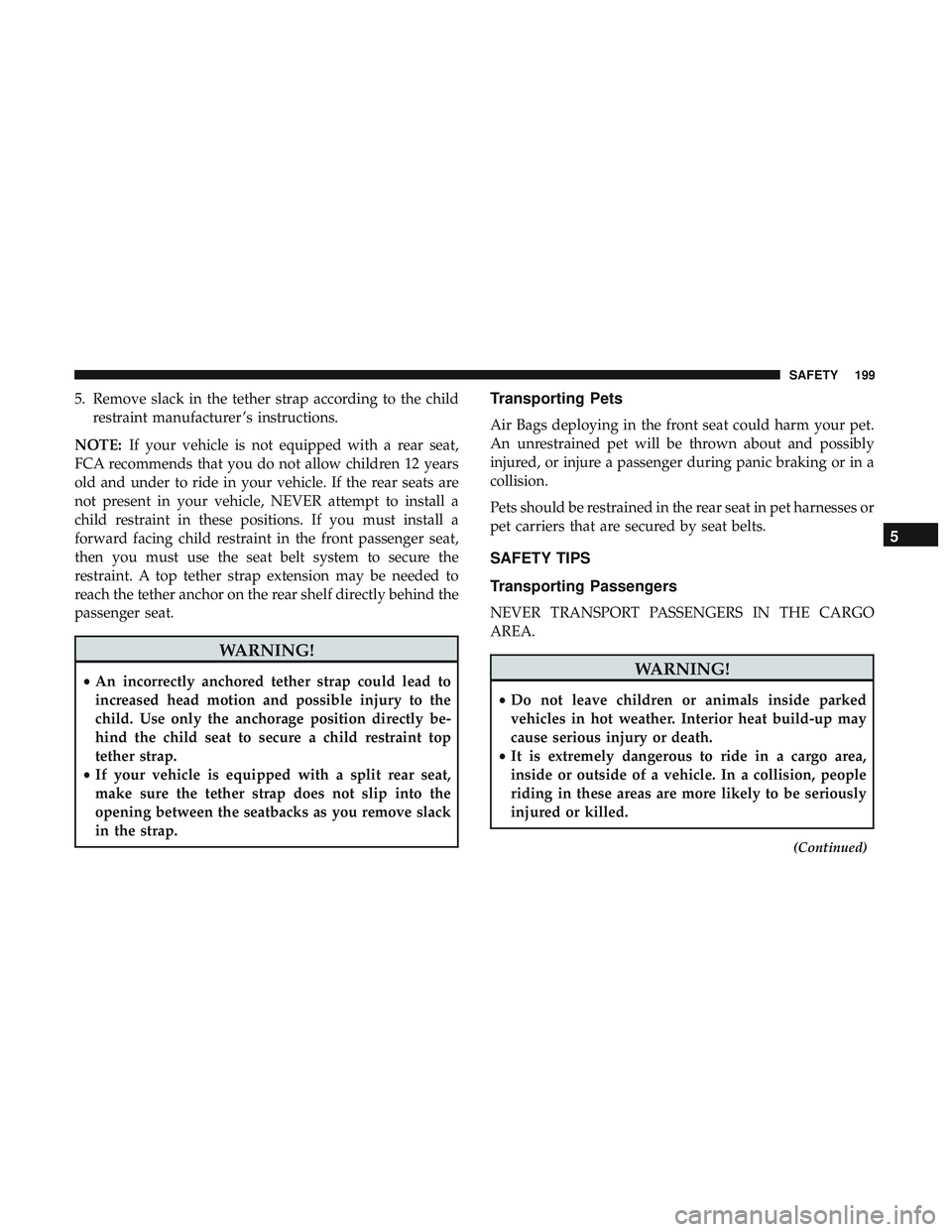
5. Remove slack in the tether strap according to the childrestraint manufacturer ’s instructions.
NOTE: If your vehicle is not equipped with a rear seat,
FCA recommends that you do not allow children 12 years
old and under to ride in your vehicle. If the rear seats are
not present in your vehicle, NEVER attempt to install a
child restraint in these positions. If you must install a
forward facing child restraint in the front passenger seat,
then you must use the seat belt system to secure the
restraint. A top tether strap extension may be needed to
reach the tether anchor on the rear shelf directly behind the
passenger seat.
WARNING!
• An incorrectly anchored tether strap could lead to
increased head motion and possible injury to the
child. Use only the anchorage position directly be-
hind the child seat to secure a child restraint top
tether strap.
• If your vehicle is equipped with a split rear seat,
make sure the tether strap does not slip into the
opening between the seatbacks as you remove slack
in the strap.
Transporting Pets
Air Bags deploying in the front seat could harm your pet.
An unrestrained pet will be thrown about and possibly
injured, or injure a passenger during panic braking or in a
collision.
Pets should be restrained in the rear seat in pet harnesses or
pet carriers that are secured by seat belts.
SAFETY TIPS
Transporting Passengers
NEVER TRANSPORT PASSENGERS IN THE CARGO
AREA.
WARNING!
• Do not leave children or animals inside parked
vehicles in hot weather. Interior heat build-up may
cause serious injury or death.
• It is extremely dangerous to ride in a cargo area,
inside or outside of a vehicle. In a collision, people
riding in these areas are more likely to be seriously
injured or killed.
(Continued)
5
SAFETY 199
Page 210 of 486
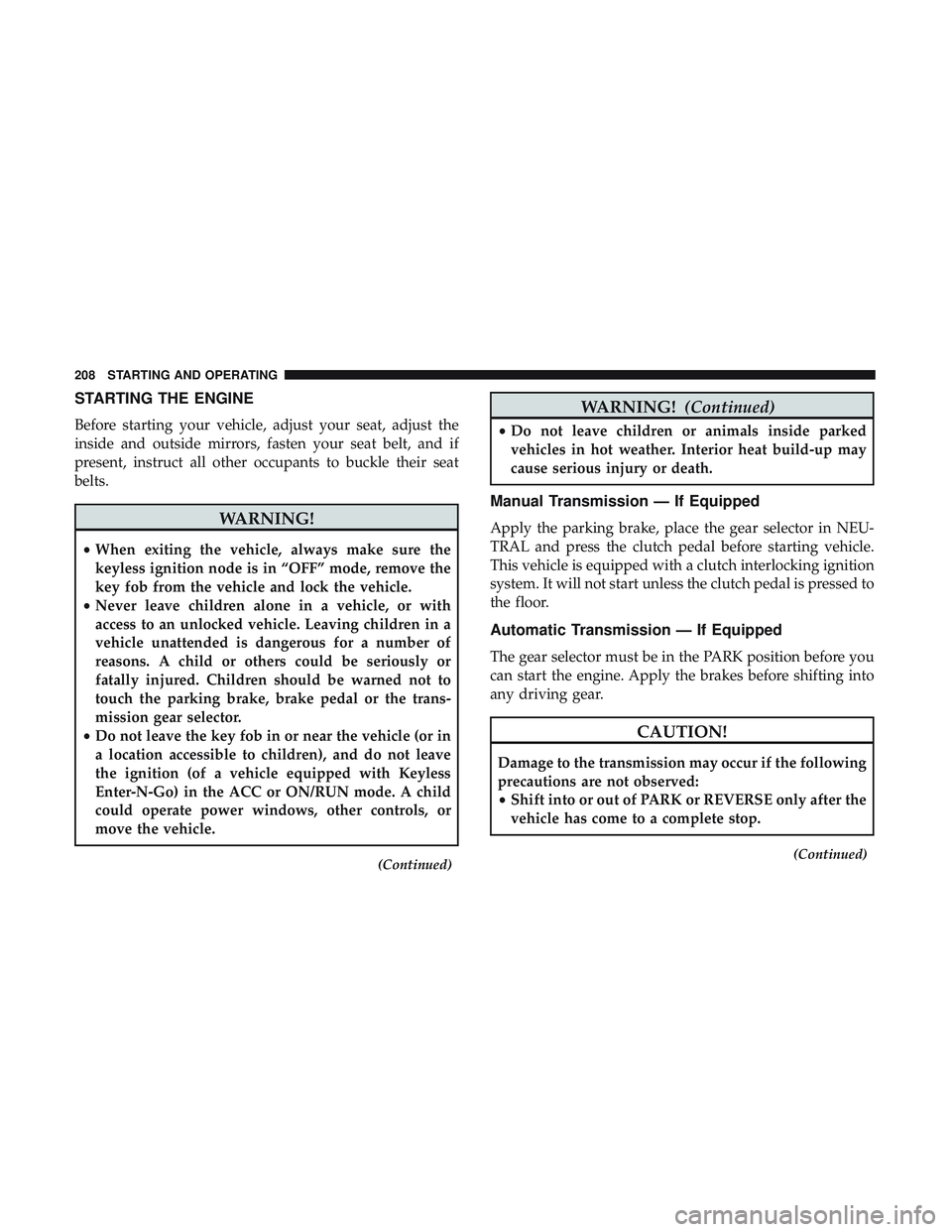
STARTING THE ENGINE
Before starting your vehicle, adjust your seat, adjust the
inside and outside mirrors, fasten your seat belt, and if
present, instruct all other occupants to buckle their seat
belts.
WARNING!
•When exiting the vehicle, always make sure the
keyless ignition node is in “OFF” mode, remove the
key fob from the vehicle and lock the vehicle.
• Never leave children alone in a vehicle, or with
access to an unlocked vehicle. Leaving children in a
vehicle unattended is dangerous for a number of
reasons. A child or others could be seriously or
fatally injured. Children should be warned not to
touch the parking brake, brake pedal or the trans-
mission gear selector.
• Do not leave the key fob in or near the vehicle (or in
a location accessible to children), and do not leave
the ignition (of a vehicle equipped with Keyless
Enter-N-Go) in the ACC or ON/RUN mode. A child
could operate power windows, other controls, or
move the vehicle.
(Continued)
WARNING! (Continued)
•Do not leave children or animals inside parked
vehicles in hot weather. Interior heat build-up may
cause serious injury or death.
Manual Transmission — If Equipped
Apply the parking brake, place the gear selector in NEU-
TRAL and press the clutch pedal before starting vehicle.
This vehicle is equipped with a clutch interlocking ignition
system. It will not start unless the clutch pedal is pressed to
the floor.
Automatic Transmission — If Equipped
The gear selector must be in the PARK position before you
can start the engine. Apply the brakes before shifting into
any driving gear.
CAUTION!
Damage to the transmission may occur if the following
precautions are not observed:
• Shift into or out of PARK or REVERSE only after the
vehicle has come to a complete stop.
(Continued)
208 STARTING AND OPERATING
Page 472 of 486
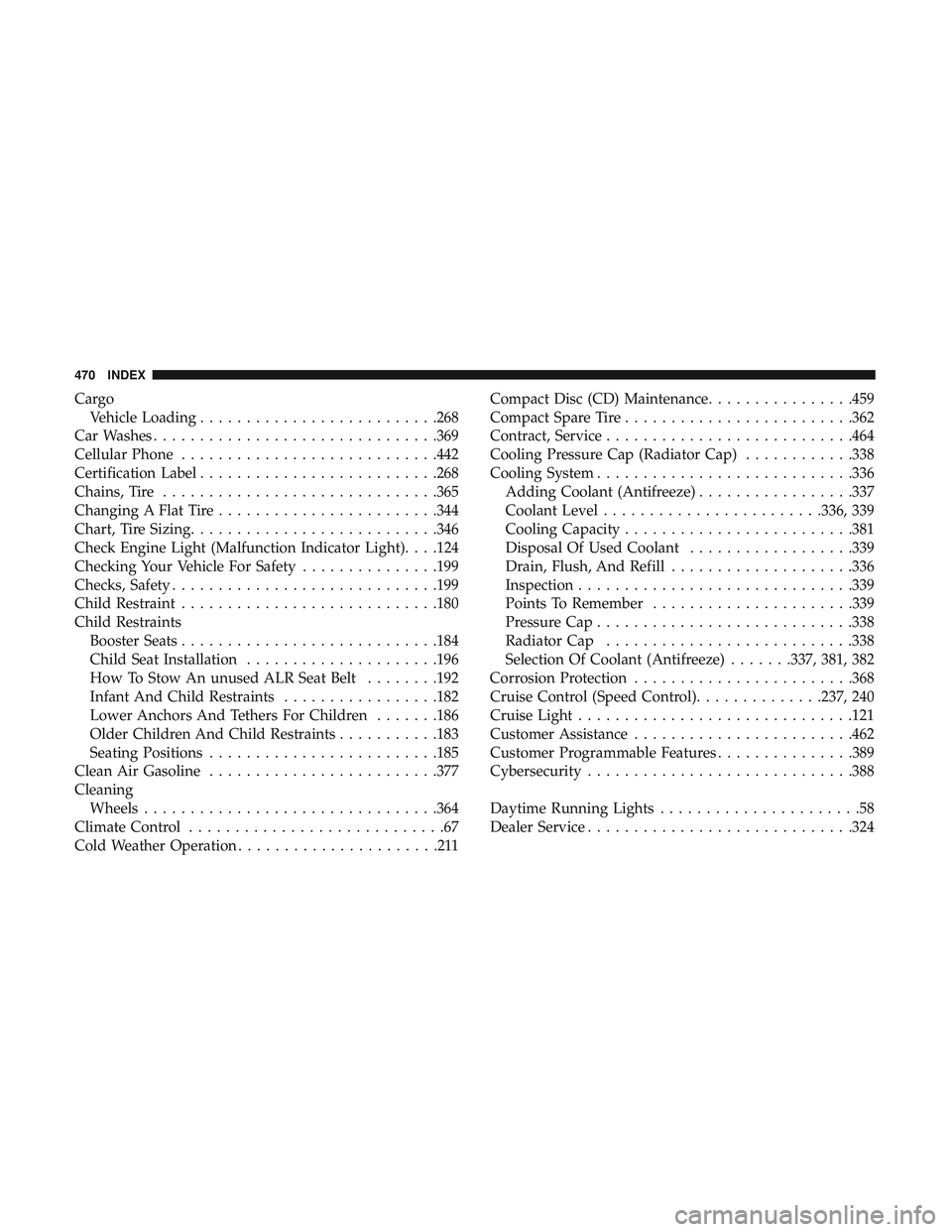
CargoVehicle Loading ......................... .268
Car Washes .............................. .369
Cellular Phone ........................... .442
Certification Label ......................... .268
Chains, Tire ............................. .365
Changing A Flat Tire ....................... .344
Chart, Tire Sizing .......................... .346
Check Engine Light (Malfunction Indicator Light). . . .124
Checking Your Vehicle For Safety ...............199
Checks, Safety ............................ .199
Child Restraint ........................... .180
Child Restraints Booster Seats ........................... .184
Child Seat Installation .....................196
How To Stow An unused ALR Seat Belt ........192
Infant And Child Restraints .................182
Lower Anchors And Tethers For Children .......186
Older Children And Child Restraints ...........183
Seating Positions ........................ .185
Clean Air Gasoline ........................ .377
Cleaning Wheels ............................... .364
Climate Control ............................67
Cold Weather Operation ......................211 Compact Disc (CD) Maintenance
................459
Compact Spare Tire ........................ .362
Contract, Service .......................... .464
Cooling Pressure Cap (Radiator Cap) ............338
Cooling System ........................... .336
Adding Coolant (Antifreeze) .................337
Coolant Level ....................... .336, 339
Cooling Capacity ........................ .381
Disposal Of Used Coolant ..................339
Drain, Flush, And Refill ....................336
Inspection ............................. .339
Points To Remember ..................... .339
Pr
essure Cap ........................... .338
Radiator Cap .......................... .338
Selection Of Coolant (Antifreeze) .......337, 381, 382
Corrosion Protection ....................... .368
Cruise Control (Speed Control) ..............237, 240
Cruise Light ............................. .121
Customer Assistance ....................... .462
Customer Programmable Features ...............389
Cybersecurity ............................ .388
Daytime Running Lights ......................58
Dealer Service ............................ .324
470 INDEX
Page 480 of 486
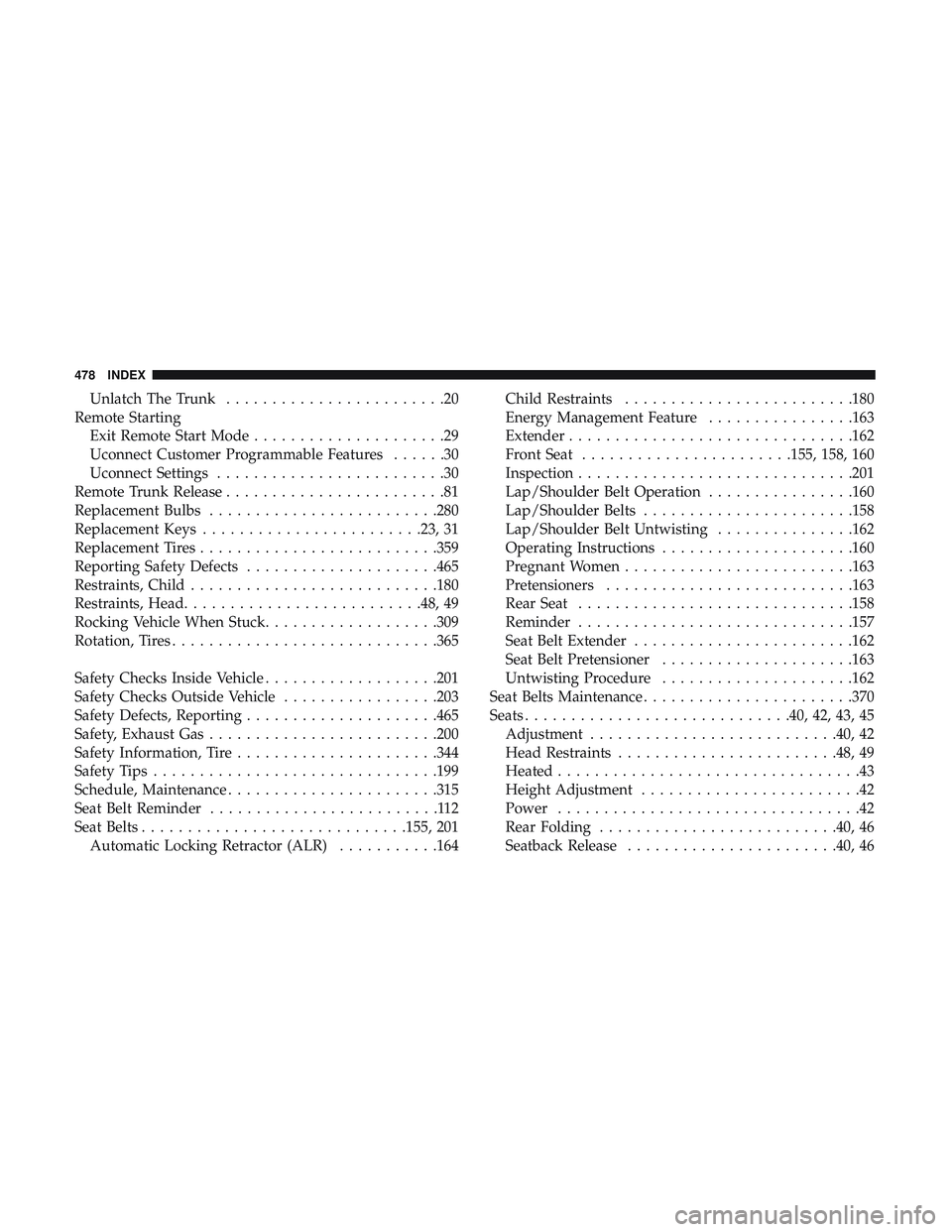
Unlatch The Trunk........................20
Remote Starting Exit Remote Start Mode .....................29
Uconnect Customer Programmable Features ......30
Uconnect Settings .........................30
Remote Trunk Release ........................81
Replacement Bulbs ........................ .280
Replacement Keys ....................... .23, 31
Replacement Tires ......................... .359
Reporting Safety Defects .....................465
Restraints, Child .......................... .180
Restraints, Head ......................... .48, 49
Rocking Vehicle When Stuck ...................309
Rotation, Tires ............................ .365
Safety Checks Inside Vehicle ...................201
Safety Checks Outside Vehicle .................203
Safety Defects, Reporting .....................465
Safety, Exhaust Gas ........................ .200
Safety Information, Tire ..................... .344
Safety Tips .............................. .199
Schedule, Maintenance ...................... .315
Seat Belt Reminder .........................112
Seat Belts ............................ .155, 201
Automatic Locking Retractor (ALR) ...........164Child Restraints
........................ .180
Energy Management Feature ................163
Extender .............................. .162
Front Seat ...................... .155, 158, 160
Inspection ............................. .201
Lap/Shoulder Belt Operation ................160
Lap/Shoulder Belts ...................... .158
Lap/Shoulder Belt Untwisting ...............162
Operating Instructions .....................160
Pregnant Women ........................ .163
Pretensioners .......................... .163
Rear Seat ............................. .158
Reminder ............................. .157
Seat
Belt Extender ....................... .162
Seat Belt Pretensioner .....................163
Untwisting Procedure .....................162
Seat Belts Maintenance ...................... .370
Seats ............................ .40, 42, 43, 45
Adjustment .......................... .40, 42
Head Restraints ....................... .48, 49
Heated .................................43
Height Adjustment ........................42
Power .................................42
Rear Folding ......................... .40, 46
Seatback Release ...................... .40, 46
478 INDEX